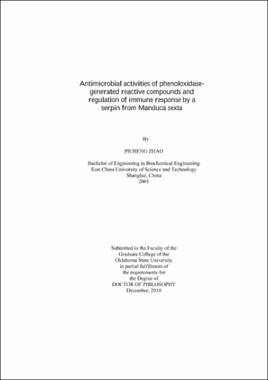| dc.contributor.advisor | Jiang, Haobo | |
| dc.contributor.author | Zhao, Picheng | |
| dc.date.accessioned | 2013-11-26T08:23:49Z | |
| dc.date.available | 2013-11-26T08:23:49Z | |
| dc.date.issued | 2010-12 | |
| dc.identifier.uri | https://hdl.handle.net/11244/6757 | |
| dc.description.abstract | Scope and Method of Study: Phenoloxidase (PO) and its activation system are implicated in several defense responses of insects. Upon wounding or infection, inactive prophenoloxidase (proPO) is converted to active PO through a network of serine proteases and their homologs. PO generates reactive compounds such as 5,6- dihydroxyindole (DHI), which have a broad-spectrum antimicrobial activity. The regulation of proteolytic activation cascade of immune response involves serine protease inhibitor (serpin) family molecules. Many serpins are found to play key roles in negatively regulating immune defense system through irreversibly inhibiting target serine proteases, not only to humoral but also to the cellular responses. A new gene, serpin-10, was found in Manduca sexta and expressed in insect cell via infection of recombinant baculovirus contain serpin-10 cDNA fragment. The serpin10 antiserum was prepared and used for determining protein level in hemolymph and affinity chromatography to analysis immune complex formation with serpin-10. | |
| dc.description.abstract | Findings and Conclusions: Here we demonstrate that DHI and its spontaneous oxidation products are active against bacteria, fungi, viruses, and parasitic wasp eggs. These results established that proPO activation is an integral component of the insect defense system. A possible mechanism of DHI toxicity is the cross-linking of proteins and nucleic acid via its oxidization products. The transcript level of M. sexta serpin-10 is higher in nerve system, trachea, and fat body than in other tissues. The transcriptional level does not change a lot during 4th and 5th instar larval stages, but decreases remarkably in middle and late pupa stage, and then recovers in adults. This gene is suppressed in fat body, which indicates it may have a relationship with immune response to pathogen invasion. The protein level of serpin-10 is quite stable in hemolymph. M. sexta serpin10 forms a covalent complex with an unknown serine protease. HP1 is present in the immune complex via non-covalent association. | |
| dc.format | application/pdf | |
| dc.language | en_US | |
| dc.rights | Copyright is held by the author who has granted the Oklahoma State University Library the non-exclusive right to share this material in its institutional repository. Contact Digital Library Services at lib-dls@okstate.edu or 405-744-9161 for the permission policy on the use, reproduction or distribution of this material. | |
| dc.title | Antimicrobial activities of phenoloxidasegenerated reactive compounds and regulation of immune response by a serpin from Manduca sexta | |
| dc.contributor.committeeMember | Dillwith, Jack W. | |
| dc.contributor.committeeMember | Marek, Stephen M. | |
| dc.contributor.committeeMember | Mort, Andrew J. | |
| osu.filename | ZHAO_okstate_0664D_11167.pdf | |
| osu.accesstype | Open Access | |
| dc.type.genre | Dissertation | |
| dc.type.material | Text | |
| thesis.degree.discipline | Entomology and Plant Pathology | |
| thesis.degree.grantor | Oklahoma State University | |
